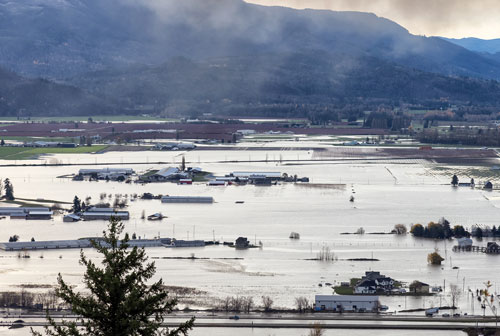1/1/2022
2021: A Song of Floods & Fires
Stephanie Saccomano

Typically, one considers “breaking a record” an achievement and a measure of success. However, this past year hosted several record-breaking events and presented a slew of unprecedented challenges. In the summer, we were met with high temperature extremes, and in November 2021, we took on historical amounts of water due to heavy rainfall and experienced catastrophic flooding, mudslides and washouts. I’d be remiss if I didn’t take this opportunity to share.
Pictured: Flooding in Abbotsford, British Columbia‚ in November 2021, not too far from Qualitree’s Chilliwack location. (EB Adventure Photography / Shutterstock.com)
The Sumas Prairie in the Abbotsford region is an agricultural hub of British Columbia. Abbotsford broke a record with 540 millimeters (21 in.) of rain over the single month of November. To put that in perspective, the average annual rainfall for Abbotsford over the last several years is 1,300 mm (51 in.). Additionally, a large percentage of that came down over several days. The term we learned was “atmospheric river.” According to the BC Minister of Agriculture, over 640,000 animals were lost in the flood and many fields of vegetable and fruit crops. It remains to be seen what impacts the putrid water will have had on the soil.
Sumas is one example of many; multiple cities across BC were impacted directly or indirectly by the flood waters and associated events. Mudslides took out hillsides, roads and homes. Portions of highways were simply deleted. For a time, there was no access in or out of Chilliwack, my hometown and location of Qualitree.
In perspective, we were fortunate. In our neck of Chilliwack, we experienced flooded fields and ditches. Some fields of container trees at Qualitree got a bit of float time, and at one point, one of our section growers had to visit an off-site rental location via a rowboat. While that period was brief and minimal in the grand scheme of things, the indirect effects of the flooding impacted us most.
With the flooding and washouts of highways, interprovincial access was shattered in various places at various times. We couldn’t plan properly for orders—loads halfway through being picked ended up being halted due to road conditions. With that, in some cases we were incapable of shipping products out in time for some holiday deadlines and lost out on sales opportunities. Retail customers on the other side of the continent don’t necessarily know or care about what isn’t at the store yet, so through the chain, hands were tied regarding product delays.
Our shipping costs went through the roof, and in some instances, nearly quadrupled. Our operations team would go from 0 to 100, as we weathered between storms and the ensuing road openings and closures. Additionally, limited access to labor meant that our busiest propagation season would experience delays. Contingency plans regarding crop cycles were discussed and prioritized.
Still, the issues we faced at Qualitree were mere inconveniences in comparison to the destruction of entire communities and infrastructure across our province. Despite this, it was heartening to see the amount of volunteers and camaraderie in the community: housing displaced persons and animals, sandbagging efforts, boat and air travel coordinated for medical access and to get people home. And, as the water recedes, volunteers continue to step in for cleanup. I was also reminded that our horticulture industry as a community is close-knit. The outreach from suppliers, customers and colleagues was incredible. I am continuously reminded why I’m thankful to work in this industry.
As the province puts away the hip waders, it’s hard to believe that half a year ago we were faced with extreme heat waves. Some crops on the nursery today survived both the 43C (109F) summer heat and a swim through recent flood waters. It’s taught us to document our reactions to these events and consider how to mitigate risk better for the future. What’s the priority if we’re short-staffed? What are we doing to protect crops from high-stress events and are there better strategies?
Ultimately, what do we learn from this and how will we improve?
After the events of the last two years, I’m setting my sights on a well-prepared 2022. Thank you, GrowerTalks, for having me in the pages this past year and thanks to the readers who would lend a few minutes out of their busy day. I hope you all have a wonderful winter season, and wish you all a new year rich in happiness and success. Onward and upward! GT
Stephanie Saccomano is Indoor Spaces Lead Grower for Qualitree Propagators in Rosedale, British Columbia, Canada.